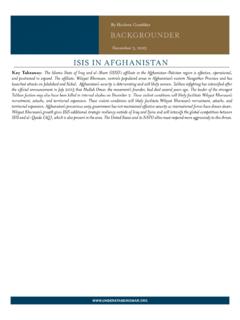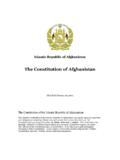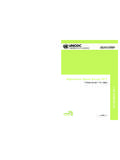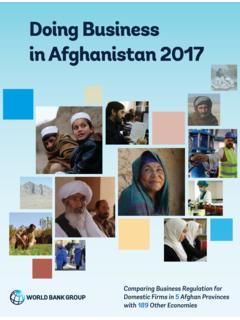Transcription of Flora and Vegetation of Afghanistan
1 Flora and Vegetation of Afghanistan Siegmar-W. Breckle Afghanistan is a very mountainous country. It offers a big variety of ecological conditions, this means a big variety of Vegetation types is covering land surface. These Vegetation types are consisting of a high biodiversity, since the floristic influence from various neighbour regions is a considerable factor in floristic and Vegetation pattern. On the other hand, Afghanistan is a very dry country with scarce rainfalls (Flohn 1969), but again very varying between north and south, west and east, lowlands and mountains. Flora of Afghanistan [click on: Vegetation map of Afghanistan ] By far the most comprehensive source for the Afghanistan Flora is Rechinger s Flora Iranica , which started in 1963 (Breckle & Frey 1976c) and is now almost completed with about 180 deliveries of the various plant families. Additionally many other short research papers on the Flora and Vegetation of various parts have been published.
2 Afghanistan is certainly a country which Flora and Vegetation has been studied quite in detail (Breckle et al. 1969, 1975, Breckle 1981, 1999), however, mainly before the critical times of the Sovjet imperialism and subsequent civil wars. Though Afghanistan is a rather dry country with a high percentage of deserts and semideserts, the number of vascular plant species is distinctly higher than in the climatically more humid Germany. GROOMBRIDGE (1992) gives an estimate of 3500 species and 30-35% of endemics, as well as about 5-10% of species, which might be added by future new discoveries. Our estimate is about 5000 species and about 25-30% of endemics. The chorological types include species with circumboreal, with holarctic, with central Asian, with himalayan, with irano-turanian, with sahara-sindian, with sudanian, with deccanic floristic relations, but then also those, which are more restricted to specific regions, as Pamir, Wakhan, Central Afghan mountains, Western, central and/or Eastern Hindu Kush.
3 Endemism is a character to be restricted to a distinct geographical unit, not to a state. This makes it difficult to judge, since many floras are written to describe the occurence of species within political borders, which normally makes not much sense. Precipitation and altitude are conditioning factors resulting in the diversity of the country's Flora . A limited area in the east and southeast receives the impact of the Indian monsoons and belongs to the sub-tropical zone. Altitude, throughout all zones, may allow for the development of different strata of Vegetation . Thus, diverse ecological conditions, ranging from barren deserts to lush sub-tropical regions to high alpine nival regions, have favored the establishment of a complex and varied Flora . Common physiognomic features of the plants of the region are gray or white hairs, gray bark that is particularly thick at the base, reduction of leaf area and cushion growth that protects the plants against the strong insolation, dry wind and sand-drift that threaten to dry them out.
4 Plants are often characterized by spiny stems and leaves or glands containing etheric (essential) oils or poisonous secondary compounds or other elements that render them unpalatable to the animals that for centuries have exerted heavy impact on the Flora . In order of numerical importance the following major families are found in Afghanistan . More than 500 species are known from the Asteraceae (Compositae) plant family, including about 100 species of Artemisia. The second biggest genus in the area is Cousinia after Astragalus. Within the Flora Iranica Rechinger (1972) mentions 355 species of Cousinia, describing not less than 61 as new species. From Afghanistan there are reported 144 species of Cousinia, 93 of them endemic to Afghanistan . 198 species from Iran, 40 from Turcomania, 31 from adjacent Pakistan, 21 from Iraq.
5 The family Fabaceae (Leguminosae) is attested with some 400 - 500 species of which the genus Astragalus is by far most numerous. In the Brassicaceae (Cruciferae) family about 250 species are found, especially Brassica, which includes cabbage, mustard and radish. There are more than 150 species of the Poaceae (Gramineae) family including such important cultivated plants as wheat, rice, barley, maize and sugar cane. Other grasses include the genera Agropyron (wheatgrass), Poa (bluegrass), Arundo (grainreed), Cymbopogon (lemon grass) and Andropogon (bluestem). In the steppes many Festuca, Bromus, Stipa spp. occur as well. More than 180 species are recorded from the Lamiaceae (Labiatae) family, including Phlomis (Jerusalem sage), Thymus (thyme), Mentha (mint), Nepeta (cat mint), Origanum and Eremostachys. The family Apiaceae (Umbelliferae) is represented by more than 100 species; most notable of which is Ferula assafoetida, an item of export and other giant hapaxanthic umbellifers from Ferula or Dorema.
6 There are many other drugs derived from naturally occuring species in the area (Breckle 1979, 1982, Breckle & Unger 1977). Chenopodiaceae halophytes are common, especially Salsola, Suaeda, Arthrophytum, Halostachys and Halocharis. On the other side the orchids (Orchidaceae), which are common in the Mediterranean and in the Himalaya spread only with few species to the area. From Afghanistan by Renz (1978) only 13 species are recorded (Iran: 48, Talysch: 28, Iraq 21, Flora Iranica total: 63). In Iridaceae, there are recorded 35 species in Afghanistan and the same number from Iran, 18 from Iraq, 10 from Turcomania, a total of 65 from the whole Flora Iranica region. A very typical genus of the drier mountain areas is Eremurus (steppe-lilies), where 23 species are known from the Flora Iranica area, 19 of those from Afghanistan and only 7 from Iran.
7 The wild Tulipa (tulips) comprise 34 species in the Flora Iranica area, 17 in Afghanistan , 18 in Iran. Vegetation of Afghanistan Vegetation all over Afghanistan has been severely influenced by man and only a few high mountain and very dry desert areas retain a quasi natural Vegetation cover. In most parts the Vegetation depends on the winter rain, in the south winter rains are often irregular. Rainfall increases to the north and east resulting in better Vegetation conditions in these parts. The eastern parts receive additionally some monsoon rains in summer. Vegetation types have been studied in detail by Freitag (1971a,b). His survey is still the most complete of the area, especially also for the eastern, monsoonal influenced more humid parts with Himalayan forest types. The main Vegetation types which are shown on the map ( Vegetation of Afghanistan ), are: Calligonum-Aristida-Sanddesert (1a) Haloxylon salicornicum-Desert (1b) Other Deserts (rich in Chenopod.)
8 (1c) Ephemeral Desert (1d) Dwarf Amygdalus-Semidesert (2) Subtropical dry Scrub and Savannah (3) Pistacia vera-Woodlands (4a) Pistacia atlantica-Woodlands (4b) Juniperus-Woodlands (5a) Amygdalus-Woodlands (5b) Sclerophyllous Oak Forests (6) Conifer Forests (7) Rhododendron-Krummholz (8) Thorny Cushions, subalpine and alpine semideserts and meadows (9) Nival belt, glaciers (10) Azonal riverine Vegetation (11a) Swamps, Salt swamps, lakes (11b) These Vegetation types indicated on the map are the natural potential Vegetation , which would be the Vegetation cover without human activities. It gives an idea on the natural potential and resources of the various regions. Today, by longlasting exploitation, grazing, agriculture and irrigation, deforestation, many of these original Vegetation types are only left on few spots, remote places, and are replaced by substituted associations poorer in shape, diversity and productivity, as well as also the soils are often degraded, eroded or totally destroyed.
9 Desert Vegetation (1) The deserts of the north, west and south, in Registan and Dashte Margo contain active sand dune areas and dunes fixed by a rather open Vegetation (1a). The Flora here is scarcely modified by man. The main plants are Haloxylon persicum, Calligonum spp. and perennial Aristida spp. In lower lying saline areas, Chenopodiaceae are dominant (1c) and in the salt plains of Seistan the Vegetation (1b) is characterized by Haloxylon salicornicum, Salsola spp., Ephedra scoparia and Tamarix spp. In some parts the ephemeral Vegetation (1d) is very characteristic, in summer these areas look totally dry and dead. In saline flats in the north the black saxaul Haloxylon aphyllum can form open woodlands, but has been heavily used, see also paragraph azonal Vegetation below. An overview on the Irano-Afghan deserts is given by Breckle (1983). Steppe and Semidesert Vegetation (2) The steppes in Afghanistan are scarce in typical steppe grasses, they should be named semi-deserts.
10 Anyhow, they are the most important grazing areas where large number of nomads graze their livestock on a seasonal basis. The low lying steppes and semideserts in the west and south are dominated by an open Vegetation of Artemisia herba-alba and other species of this genus, Zygophyllum spp., other dwarf shrubs are spiny Amygdalus (2), partly Acantholimon spp., Acanthophyllum spp., Atriplex spp., Alhagi camelorum, and Cousinia spp., the graminoids are often reduced by heavy grazing, Poa, Agropyrum, Stipa, Festuca, Carex and others are more common only on remote or inaccesible areas. An Amygdalis brahuica community is found between 1000 and 2000 m altitude also in the dry valleys of the east. Along dry river beds there are thorny belts of Stocksia brahuica, Amygdalus communis and Convolvulus spinosus. The floral composition is very variable and depends on humidity, length of winter, sand composition, wind force and grazing pressure.







